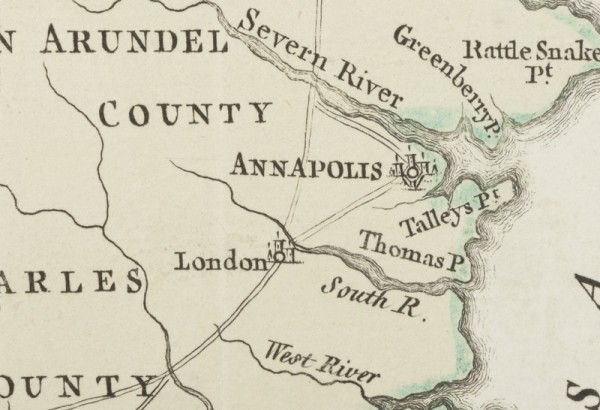
Joshua Fry and Peter Jefferson, Map of the Most Inhabited part of Virginia, containing the whole province of Maryland with part of Pensilvania, New Jersey and North Carolina (detail), 1754. (Colonial Williamsburg Foundation.) The map shows the close proximity of London Town to Annapolis.

The Edward Rumney/Stephen West Tavern cellar during archaeological excavations, 2001. (Photo, Al Luckenbach.) The William Brown House and Tavern at Historic London Town can be seen in the distance.

Amorial plate, Portugal, tin-glazed earthenware. D. 10 3/8". (Courtesy, Maryland State Archives; photo, Gavin Ashworth.) The fragments of this complete vessel were found on the floor of the cellar at the Broadneck site.

The Great Seal of Talbot County, Maryland. The design was originally based on the Lloyd family arms.

Crumhorn (“crooked horn”) pipe, attributed to Emmanuel Drue, Providence, Maryland, ca. 1650–1669. Low-fired earthenware. L. 4 13/16". (Courtesy, Anne Arundel County Lost Towns Project; photo, Shawn Sharpe.) This highly decorated, unique form is considered to be a presentation piece made by Drue.

Three pieces of a pipe with a distinctive, very large heel termed Drue Type C. These sherds were excavated at the Burle site at Providence nearly a decade before the stamp on the right was recovered at Swan Cove. (Photos, Gavin Ashworth.)

Archaeological site plan showing building sequence at Homewood’s Lot (18AN871), 2004. (Courtesy, Anne Arundel County Lost Towns Project.) Evidence for five separate buildings were discovered with construction dates between ca. 1650 and ca. 1700.

Mid-drip candlestick fragments, probably England, 1660s. Tin-glazed earthenware. (Courtesy, Anne Arundel County’s Lost Towns Project; photo, John E. Kille.) These fragments were recovered from Homewood’s Lot “Building A” cellar.
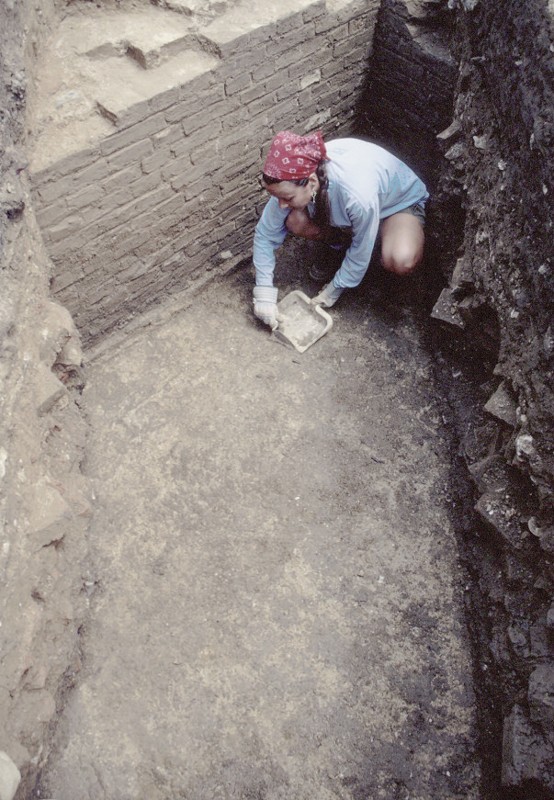
Erin Cullen excavating the brick cellar under “Building D” at Homewood’s Lot, in 2002. (Photo, Al Luckenbach.)

Bowl fragment, Netherlands, ca. 1640–1680. Tin-glazed earthenware. D. 10". (Courtesy, Anne Arundel County’s Lost Towns Project; photo, Al Luckenbach.)

The Calvert House, State Circle, Annapolis, Maryland, 2016. (Photo, Al Luckenbach.)

Punch bowl fragment, probably Liverpool, England, ca. 1754–1765. Tin-glazed earthenware. L. 6". (Photo, Al Luckenbach.) This fragment is part of a larger number of archaeologically derived vessels on display at the Calvert House.

Tankard, Westerwald, Germany, 1750s–1760s. Salt-glazed stoneware. H. 6 1/2". (Private collection; photo, Al Luckenbach.) This remarkably intact vessel was excavated by bulldozer.

Wine bottle, England, 1750s–1760s. Glass. H. 9 1/2". (Courtesy, Anne Arundel County Lost Towns Project; photo, Shawn Sharpe.)
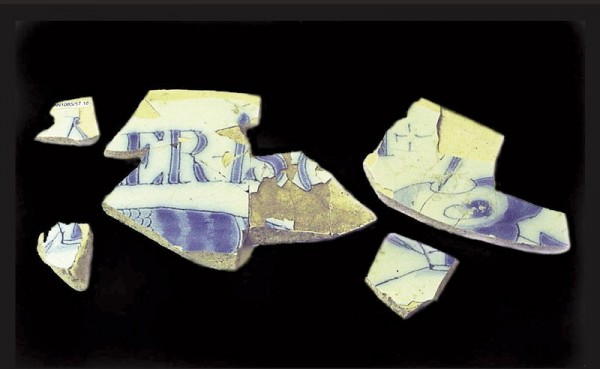
Punch bowl fragments, probably Italian, early eighteenth century. Max. L. 4". (Courtesy, Anne Arundel County Lost Towns Project; photo, Al Luckenbach.)

Punch bowl fragments, London, England, early eighteenth century. Max. L. 2 1/2". (Courtesy, Anne Arundel County Lost Towns Project; photo, Shawn Sharpe.) These fragments from a single vessel represent the only ceramics from the courthouse cellar at London Town..

Tin-glazed earthenwares recovered from the Rumney/West Tavern cellar. (Courtesy, Anne Arundel County Lost Towns Project; photo, John E. Kille.) This tightly dated ca. 1725 context produced a total of thirty-seven vessels.

Spiked bowl fragment, England, ca. 1725. Tin-glazed earthenware. H. of spike 1 1/4". (Courtesy, Anne Arundel County Lost Towns Project; photo, Gavin Ashworth.) This so-called pineapple bowl may have held butter or sugar instead. Note the interesting use-wear patterns that appear on the three edges of the pyramidal spike.
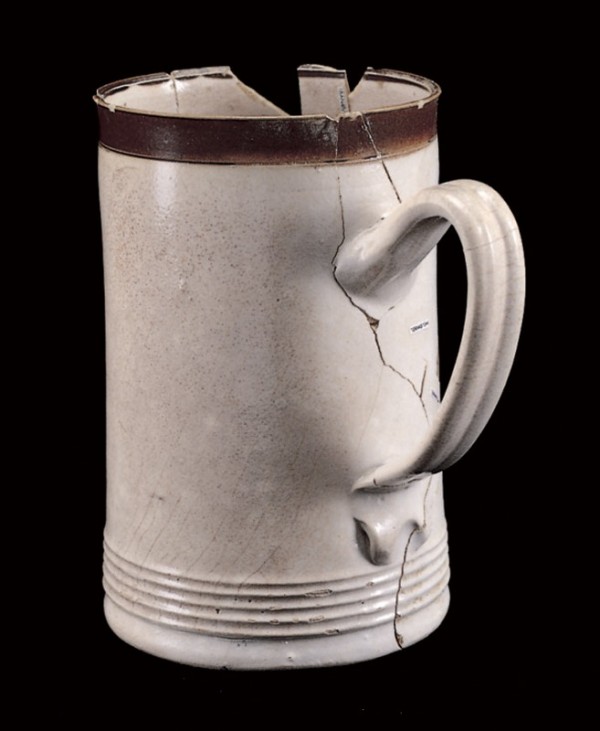
Tankard, attributed to John Dwight, Fulham, London, England, ca. 1720. Salt-glazed stoneware. H. 6 1/2". (Courtesy, Anne Arundel County Lost Towns Project; photo, Gavin Ashworth.)

Beverage vessels, Fulham, London, England, ca. 1720. Salt-glazed stoneware. (Courtesy, Anne Arundel County Lost Towns Project; photo, John E. Kille.) The ten salt-glazed vessels recovered from the Rumney/West Tavern cellar are important for their early date.

Coffeepot fragments, England, ca. 1720. Lead-glazed stoneware. (Courtesy, Anne Arundel County Lost Towns Project; photo, Gavin Ashworth.) These English brown and off-white fragments include part of the handle and the acorn-shaped finial from the lid.
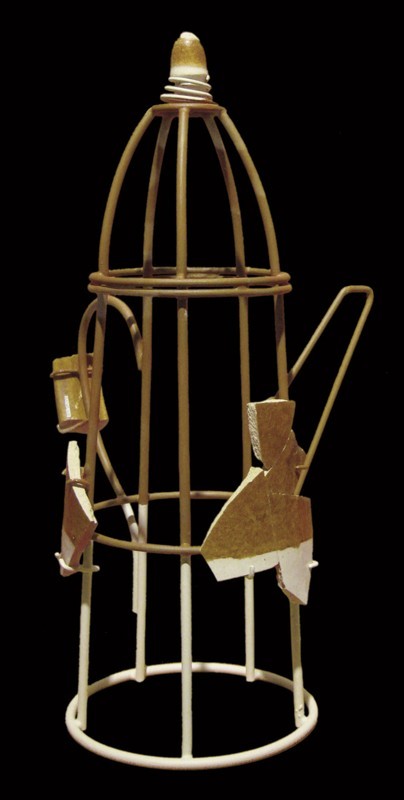
Coffeepot fragments from the Rumney/West Tavern arranged on a wire frame in the shape of the original vessel for a stoneware exhibition at the Colonial Williamsburg Foundation. (Courtesy, Colonial Williamsburg Foundation.) The reconstruction is now on display at Historic London Town in Edgewater, Maryland.
